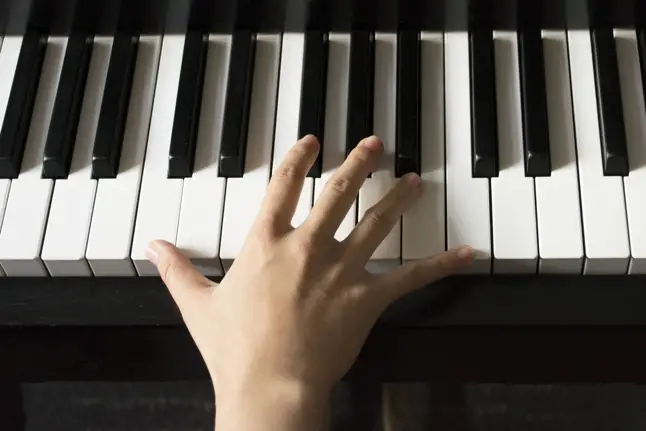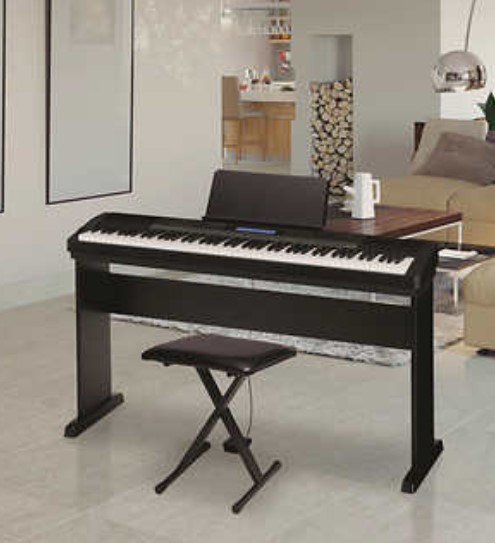
Please click image for more info
Some piano students find it hard to switch from a beginner-level keyboard to a real piano, because many beginner keyboards lack important features in a real piano. That’s not the case with solid entry-level keyboards, and in this Casio CDP-240 review, we cover one keyboard that lets you enjoy the feel of a real piano at an unbeatable price. This Casio CDP-240 review will tell you everything you should know before making a decision whether you should purchase this keyboard.
The Casio CDP-240 is a digital piano featuring 88 weighted keys that provide the user an experience similar to a real piano. The different pressure responses amplify the sound and, as a result, help you achieve the playing feel that you’re looking for.
Table of Contents
- Casio CDP-240 Overview
- Video Overview of Casio CDP-240
- Casio CDP 240 Specifications
- Who the Casio CDP-240 is Most Suitable For?
- What’s Included In the Box of Casio CDP-240?
- Features of Casio CDP-240
- YouTube Tutorial Videos
- Casio CDP-240 Manual
- Casio CDP-240 vs. Yamaha P71
- Jeremy See’s Casio CDP-240 Review
- Conclusion
Weighting ~42 pounds, Casio CDP 240 is portable but not as portable as other lightweight Casio keyboards. But priced at less than $500 and equipped with numerous built-in songs for the user to practice on, this keyboard is a great option for beginners who’re keen to learn on a full 88-key weighted keyboard.
Casio CDP-240 Overview

The Casio CDP-240 has 88 weighted keys that enable the user to mimic the experience of a real piano. Each of the 88 keys comes with three different pressure responses, which implies that the quality and grade of sound you produce depends on how softly or hard you press the keys.
It has hundreds of in-built songs that offer the users numerous song options to start practicing with. The Music Challenge, along with numerous other learning features that this keyboard comes equipped with further encourages the user to polish their skills and up their piano playing game.
It also allows you to incorporate the sound of different musical instruments to your performance, including guitar, organ, winds, drums, bass, and more. The 16-Watt speakers ensure that the sound produced is of the finest quality. The best thing is that it comes with two outputs that you can use to plug in your earphones, so you don’t have to worry about disturbing anybody with your practice sessions.
Other noteworthy features include recording functions, external SD card support for additional storage, arpeggiator, etc. The USB port for the MIDI interface further makes this keyboard an option worth your consideration.
Video Overview of Casio CDP-240
CDP-240 Unboxing:
CDP-240 Features:
Casio CDP 240 Specifications
|
Specification |
Description |
|---|---|
|
Keys |
88 weighted keys |
|
Touch Response |
3 levels |
|
Polyphony |
64 note |
|
Lessons |
Step-Up Lesson |
|
Tones |
700 |
|
Rhythm |
200 auto-accompaniment rhythms |
|
Songs |
152 built-in songs |
|
Connectivity |
USB, MIDI |
|
Storage |
SD card |
|
Recorder |
Recorder function present |
|
Speakers |
16-watt |
|
Weight |
42 pounds |
|
Dimensions |
28.6 cm x 132.2 cm x 12.9 cm |
|
Accessories |
Power cord, SP-3 sustain pedal, user manual, music stand, two-sheet music booklets, a stand kit, mini audio cord, quilted bench |
Who the Casio CDP-240 is Most Suitable For?

Casio CDP 240 is an excellent option for beginners and a good choice for more seasoned keyboard players who’re shopping for a piano on a budget.
152 built-in songs, 100 demo songs, 50 practice exercises, Music Challenges, and the Step-Up Lesson system make this digital piano an ideal option for beginners who wish to learn to play the piano like a pro.
Unlike most beginner-level keyboards, it features 88 keys. Most beginner-level keyboards only have 61 keys. This means that when you finally switch to a professional piano, you can get used to the 88 weighted keys quickly!
The 88 weighted keys make the Casio CDP-240 are a good choice for users who are already equipped with the piano playing skill and are looking for a more advanced keyboard at an affordable price to further polish their skills before investing in a real, acoustic piano. The primary reasons why it is suitable for a seasoned piano player are that it has 88 keys and three levels of touch sensitivity that produce a sound similar to that of an acoustic piano.
All in all, Casio CDP 240 is most suitable for beginners but also makes a great choice for seasoned keyboard players!
What’s Included In the Box of Casio CDP-240?
When you go to purchase the Amazon exclusive product, you’re actually bagging in an extraordinary deal for yourself. Priced at under $500, you’ll be surprised to know what’s included with this digital piano. You get a power adaptor, an SP-3 sustain pedal, a user manual, a stand for music sheet, a piano stand, a piano bench, two songbooks, and mini audio cable! You really don’t have to worry about buying anything else out of the package because it certainly has it all in the price. How amazing is that?
Features of Casio CDP-240
The extraordinary features are what makes Casio CDP 240 such a popular choice among beginners. Let’s have a look at each of the features individually below.
|
FEATURE |
DESCRIPTION |
|---|---|
|
Keys |
Unlike most of the beginner keyboards available today, this digital keyboard features 88 weighted keys. It is one of the few beginner keyboards that offer an experience similar to that of a real piano, thanks to the three pressure responses. The three levels of touch response that each of the 88 keys come with enable you to enjoy the feel of an acoustic piano. The harder you hit the keys, the louder the sound will be. It won’t be wrong to say that this is a complete digital piano that is as close to a real piano as possible for a beginner keyboard to be! |
|
LCD Screen |
The top side features an LCD display screen. The LCD display is a super-helpful feature when it comes to the learning phase. It displays an outline of the two hands. As you play a song, certain fingers on the outlined hands light up, indicating the keys on the piano that you have to press to achieve that sound. It is a unique feature that you won’t find in many digital keyboards. |
|
Learning Features |
The learning features are one of the best that you will find today. It not only features 152 built-in songs, but it also has 50 exercises, Music Challenges, and a Step-Up Lesson that aid you to learn and polish your piano playing skills. You can choose the song of your choice from the built-in song library and play along.
The Step-Up Lesson mode is truly noteworthy. When you activate this mode, the LCD screen, as mentioned earlier, highlights the fingers and the keys that you’ve to press to play the song that you chose. It is like a digital teacher that helps you learn to play the piano step by step, key by key.
As all of the above-mentioned features weren’t enough, the Music Challenge features enable you to bring your piano playing skills to test, which further encourages you to play the piano like a champ! |
|
Sound Quality |
This review can’t be complete without mentioning the sound quality. It features 700 voices, including voices of guitars, strings, winds, organs, and more other than the piano itself. As a result, you can enjoy full-fledge, high-quality performances. It also features 16-watt high-quality in-built speakers, which make it possible for you to play the piano at parties and gatherings, loud and clear!
In addition, 64-note polyphony and 200 auto-accompaniment rhythms further add to the sound quality of Casio CDP 240. |
|
Audio Output |
The Casio CDP-240 has two audio outputs that allow you to attach your earphones and practice in silence and privacy. This feature is specifically useful for those who do not have a separate studio to practice and are often bashed by neighbors and family members for creating a disturbance at odd times during the day.
Moreover, two audio outputs also mean that your teacher or partner can listen to your performance with you in complete silence and privacy. |
|
Speakers |
Casio CDP 240 features powerful 16-watt speakers that produce loud, clear, and vibrant sound, making this keyboard by Casio a great option for users who enjoy playing the piano for friends and family! |
|
Connectivity |
Casio CDP 240 also features a USB and MIDI port. You can use this keyboard as a MIDI controller while working with DAWs and other music software for editing your music or other keyboard learning software. The USB port allows you to access any songs from your external devices that you wish to play on your keyboard. Therefore, the built-in 152 songs aren’t all that you’ll ever have. You can practice as many songs and whichever songs that you like through the USB and MIDI connectivity! |
|
SD Card Support |
Casio CDP 240 also has SD Card slot available that allows you to load songs of your choice to the instrument and even record your performances and save them to listen sometime later or share with your friends any time you want. |
YouTube Tutorial Videos
If you want a visual guide on how to use the Casio CDP-240, you can always take help from YouTube tutorial videos. Some of the best YouTube tutorial have been listed down below:
Casio CDP-240 Manual
Casio CDP-240 is available exclusively on Amazon. Hence, its official user manual isn’t available on the official manufacturer website. You will get the hard copy of the user manual with the package!
Casio CDP-240 vs. Yamaha P71
Casio CDP-240 and Yamaha P71 are both great options for beginners that are exclusively available on Amazon. Both these digital keyboards have 88 weighted keys that give them a feel of a real piano. As much as the two are similar, there are certain features that make the two different. Let’s have a look at the features that make the two different and see which one is a better option among the two!
Portability
The first and foremost feature that sets the Casio CDP-240 and Yamaha P71 apart is the level of portability. The Casio CDP-240 weighs 42 pounds whereas, the Yamaha P71 weighs only 25 pounds making it far more portable. The lesser weight of the Yamaha P71 makes it easier to carry around and travel with. Yamaha P71 is a model in the portable series by Yamaha, which is an ideal option for travelers.
Touch Sensitivity
This digital piano comes with 3 touch sensitivity levels, whereas the Yamaha P71 comes with 4 of them, including Fixed, Hard, Medium, and Soft, enabling the user to play the keyboard as per their liking and preferences.
Pedals
The Casio CDP-240 comes with a single sustain pedal. The Yamaha P71 comes with 2 pedals, producing a sound of much better quality.
Piano Stand
The good thing about the Casio CDP-240 is that it comes with a piano stand. The Yamaha P71 does not have a piano stand included in the package. If you want a stand for your Yamaha P71, you’ll have to purchase it separately.
Headphones Jack
The Casio CDP-240 has 2 headphone jacks as compared to a single headphone jack in the Yamaha P71. You can enjoy private piano sessions with your partner and your teacher with the Casio CDP-240, which is not quite possible with the Yamaha P71.
Storage
The Casio CDP-240 features an SD card for extra storage, whereas the Yamaha P71 does not have this feature.
Jeremy See’s Casio CDP-240 Review
Conclusion
The Casio CDP-240 is a great choice for entry-level keyboard players who are looking for a basic yet powerful instrument to start with. It comes as a complete package, which means you don’t have to spend any money other than the package itself. However, when compared with the Yamaha P71, the Yamaha P71 features all that the Casio CDP-240 has and more, making Yamaha P71 a relatively better option.

Please click image for more info
But that doesn’t imply that the Casio CDP-240 is any less of a reliable and smart choice. To conclude the Casio CDP 240 review it is safe to say that this keyboard is equipped with remarkable learning features for the beginners, it’s a complete resource pack for piano enthusiasts, from beginners on up.

